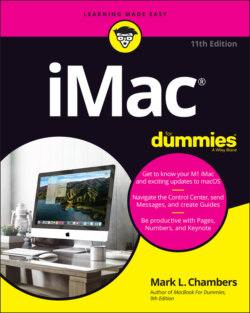Читать книгу iMac For Dummies - Mark L. Chambers - Страница 45
Importing Documents and Data from Your Old Mac
ОглавлениеIf you’re upgrading from an older Mac computer running a previous version of macOS to your new iMac, I have great news for you: Apple includes the Migration Assistant utility application that can help you move (whoops, I mean, migrate) all sorts of data from your old Mac to your new machine. The list of stuff that gets copied over includes:
User accounts: If you set up multiple user accounts (so that more than one person can share the computer), the utility ports them all to your new iMac.
Network settings: Boy howdy, this is a real treat for those with manual network settings provided by an ISP or network administrator! Migration Assistant can re-create the entire network environment of your old Mac on your new iMac.
System Preferences settings: If you’re a fan of tweaking and customizing macOS to fit you like a glove, rejoice. Migration Assistant actually copies over all the changes that you’ve made within System Preferences on your old Mac! (Insert sound of angelic chorus of cherubim and seraphim: Hallelujah!)
Documents: The files in your Documents folder(s) are copied to your new iMac.
Applications: Migration Assistant tries its best to copy over the third-party applications that you’ve installed in your Applications folder on the older Mac. I say tries its best because you might have to reinstall some applications, anyway. Some developers create applications that spread out all sorts of files across your hard drive, and Migration Assistant just can’t keep track of those nomadic files. Also, some other applications make the trek just fine, but you might have to re-enter their serial numbers.
If you’re migrating from an Intel Mac to a new M1 iMac, you may also find that some applications can no longer be launched — unfortunately, these apps are not compatible with Apple’s processor. I recommend checking with the software developer to see whether a new version of the app that supports the M1 processor is available.
Setup launches Migration Assistant automatically if you indicate that you need to transfer stuff during the setup process, but you can also launch Migration Assistant manually at any time. Click the Launchpad icon on the Dock (which bears a rocket-ship icon); then click the Search box at the top of the screen and type Migration. Click the Migration Assistant icon to launch the application. Note that Migration Assistant will close any running applications, so make sure to save and close any open documents.
To use Migration Assistant to copy your system from your older Mac, you need one of the following:
Wired or wireless network connection between the computers: If you’ve already hooked up your new iMac to your wired or wireless Ethernet network while using Setup Assistant, eschew cables completely and click Use Network instead. (Note, however, that a Wi-Fi migration will be much slower than migrating with either a direct cable connection or a wired network connection.)
Thunderbolt cable (compatible with all recent iMac, Mac mini, Mac Pro and MacBook models): A Thunderbolt connection will transfer your data between the two computers at lightning speed! (Bad pun intended.) Apple sells a Thunderbolt 3 cable that’s perfect for the job for $39 at the Apple Store.
Time Machine external drive or an AirPort Time Capsule backup unit: If you’re using Time Machine on the older Mac with an external drive, you can migrate directly from your most recent backup — just plug your external Time Machine drive into your new iMac. The same option applies if you’ve invested in Apple’s Time Capsule wireless backup device.
If you’ll be using a Thunderbolt cable, make sure that the two machines are connected with the cable first. If you’re using a network connection, both computers should be connected to the same network. Typically, you’ll also have to load Migration Assistant on the source Mac (or a free Windows program downloaded from www.apple.com, if the source computer is a PC).
After the two computers are connected, simply follow the onscreen instructions displayed within the Migration Assistant window. The application will lead you through the process step by step. If you need to return to the previous step at any time, click the Back button that appears at the bottom of the screen.
